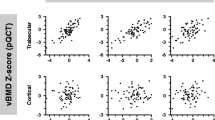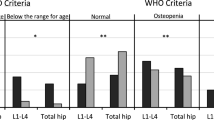Abstract.
Anorexia nervosa (AN) is classified as a high-risk factor for osteoporotic fractures. Dual X-ray absorptiometry (DXA) is the most popular method for measuring bone loss, but it is less sensitive than quantitative computed tomography (QCT). We compared DXA and QCT in measuring the lumbar spine of 17 female patients with AN and 27 healthy subjects. We found discordance between DXA and QCT using World Health Organization (WHO) criteria with the T-score. With QCT as a reference method because of its sensitivity, we found one false-negative, one false-positive, and two misdiagnosed cases. We suggest some correction factors to improve DXA evaluation and screening of bone loss in AN.
Similar content being viewed by others
Author information
Authors and Affiliations
Corresponding author
Rights and permissions
About this article
Cite this article
Masala, S., Jacoangeli, F., Fiori, R. et al. Densitometric evaluation in women with anorexia nervosa. Acta Diabetol 40 (Suppl 1), s177–s179 (2003). https://doi.org/10.1007/s00592-003-0059-1
Issue Date:
DOI: https://doi.org/10.1007/s00592-003-0059-1




